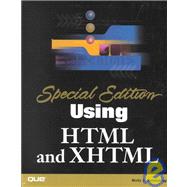Special Edition Using HTML & XHTML is a comprehensive Web publishing reference, providing practical solutions to real-world Web development problems. Author Molly Holzschlag starts by explaining how XHTML differs from HTML and why it's necessary, but quickly moves beyond a mere comparison of the differences. The reader learns which tools are best, how to code HTML & XHTML, and the basic principles of Web publishing and graphic design. The book also shows how to integrate graphics, stylesheets, frames and multimedia into XHTML Web pages. Later chapters cover XHTML's relationship to XML and creating content for alternative devices including pagers, cell phones, and hand held devices.








